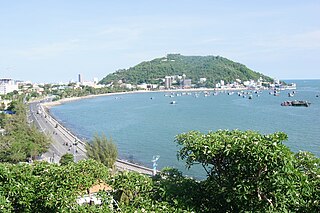Articles related to Vietnam and Vietnamese culture include:

Bà Rịa–Vũng Tàu is a province of Vietnam. It is located on the coast of the country's Southeast region. It also includes the Côn Đảo islands, located some distance off Vietnam's southeastern coast. From 1954 to 1975, under South Vietnam, the province was called Phước Tuy.

Vũng Tàu is the largest city of Bà Rịa–Vũng Tàu province in southern Vietnam. It is the province's economic, financial and cultural centre, and a popular tourist hub in southern Vietnam. The city area is 141.1 square kilometres, consists of 16 urban wards and one commune of Long Sơn Island. Vũng Tàu was the capital of the province until it was replaced by the much smaller Bà Rịa city on 2 May 2012. The city is also the crude oil extraction center of Vietnam.

Bến Tre is a province of Vietnam. It is one of the country's southern provinces, and is situated in the Mekong Delta. It is also famous for its coconuts and the Coconut Religion nationwide. Disconnected from the mainland, the province lies mainly on 2 river islands. It has land borders only with Vĩnh Long Province, which occupies the western tip of the southern river island.

Tiền Giang is a province in the Mekong Delta region of southern Vietnam.

Thủ Dầu Một is the capital city of Bình Dương province, Vietnam, located at around 10°58′0″N106°39′0″E. The city has an area of 118.91 km², with a population of 336.705, and is located 20 km north of downtown Ho Chi Minh City, on the left bank of the Saigon River, upstream from the city.

Bà Rịa is a city in Bà Rịa–Vũng Tàu province in the Southeast region of Vietnam. Bà Rịa is adjacented to Vũng Tàu by Cỏ May river and connected by Cỏ May Bridge on National Route 51. This is the de jure seat of the province since most of the provincial administration agencies are located here. Since May 2012, Bà Rịa officially replacing Vũng Tàu to become the provincial capital of Bà Rịa–Vũng Tàu.
Tan Thanh may refer to several populated places in Vietnam:

Đồng Hỷ is a rural district of Thái Nguyên province in the Northeast region of Vietnam. As of April 1, 2019, the district had a population of 92.421. The district covers an area of 427,73 km2. The district capital lies at Hóa Thượng.

Ho Chi Minh City metropolitan area is a metropolitan area that was in June 2008 proposed by the Ministry of Construction of Vietnam to the Government of Vietnam for approval. According to this master plan, this metropolitan area will include provinces around Ho Chi Minh City in the Southeast region and 2 provinces in the Mekong Delta region.
Phú Mỹ is a district-level town of Bà Rịa–Vũng Tàu province, Vietnam.
Tân Phú may refer to several places in Vietnam, including:
Tân Hòa may refer to several places in Vietnam, including:

Trường Sa is an island district of Khánh Hòa province in the South Central Coast region of Vietnam. It was established on the basis of the Spratly Islands, which is also claimed wholly or in part by Brunei, China, Malaysia, the Philippines and Taiwan. According to the 2009 census, the district has a population of 195 people.

The Six Provinces of Southern Vietnam is a historical name for the region of Southern Vietnam, which is referred to in French as Basse-Cochinchine. The region was politically defined and established after the inauguration of the Nguyễn dynasty, and called by this name from 1832, when Emperor Minh Mạng introduced administrative reforms, to 1867, which culminated in the eight-year French campaign to conquer the Six Provinces.
Bàu Bàng is a rural district of Bình Dương province in the Southeast region of Vietnam. It was established on December 29, 2013, and has a population of over 82,000.

Imperial Concubine Phi Yến, born Lê Thị Răm, is a controversial local legend of the Côn Đảo archipelago, Bà Rịa–Vũng Tàu province. According to the legend she was the concubine of Lord Nguyễn Phúc Ánh and gave birth to a son known as Prince Cải, she advised Lord Ánh not to ask foreigners for help as that would make their victory less glorious and might cause issues in future, these comments caused Lord Ánh to be suspicious of her motives and to lock her up in a cave. Later when their toddler asked where his mother was he killed him. She grieved their son and later committed suicide as she was touched by a butcher during a vegetarian festival seeing it as "harming her honour as a concubine". This caused the villagers of Côn Đảo to hold a festival in her honour every year.













